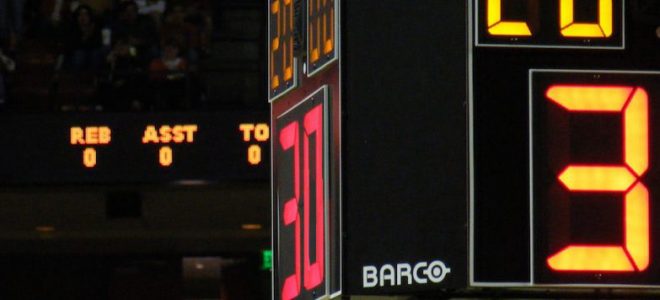

Scott Yenor is Professor of Political Science at Boise State University. He is the author of Family Politics: The Idea of Marriage in Modern Political Thought (Baylor 2011) and Hume’s Humanity: The Philosophy of Common Life and Its Limits (Palgrave 2016).
The high school basketball season is over, and Idaho still needs a shot clock. A shot clock would improve the quality of play for high school basketball, teaching the skills of seizing opportunities and attacking and rewarding hard-nosed defense. It would also prepare athletes for the next level. Idaho should follow the lead of the Dakotas in adopting the shot clock gradually with the aim of bringing its benefits to all.
TALES FROM SHOT CLOCK STATES
Eight states use a shot clock in high school basketball: Maryland, Massachusetts, California, Rhode Island, Washington, North and South Dakota, and New York.
South Dakota adopted the shot clock for Class A in its April 2013 convention, by a vote of 26 in favor and 21 opposed. Its smaller Class B schools rejected the shot clock 13-49 at the same convention. Then at the April 2016 convention, the small schools reversed their earlier decision and adopted the shot clock by a 48-21 margin.
North Dakota adopted the shot clock for its 2001 season. Its smaller schools did not adopt the shot clock until 2013.
Maryland girls basketball has had the shot clock since the early 1990s and its private schools adopted a 35-second clock in 2012, but only in 2017 did Maryland add the shot clock for boys basketball.
Wisconsin initially decided to adopt the shot clock, starting in the 2019-2020 season, but then reversed its decision before implementing it, mostly, it seems, for cost considerations expressed by small schools.
No state has adopted the shot clock and used it and then gone back. These states phased in the shot clock, starting with bigger schools. Small schools came to demand it.
A QUESTION OF HOW, NOT HOW MANY
Scoring does not necessarily go up with the shot clock.
Rather, as Bud Postma, the South Dakota athletic commissioner, said to me, “how the scoring happens changes.” Imagine a team down by six points with three minutes left that takes the air out of the ball. The team down six must begin to foul earlier, in the hopes of catching up and increasing the number of possessions. The scoring then happens at the free throw line.
With the shot clock, a team down six with three minutes to play can still hope to get back in the game. Defensive stops, not free throws, provide the best avenue for the comeback. “The shot clock makes the last four minutes of the game much more interesting for fans, coaches, and players,” said Postma. “It’s the greatest thing for basketball since sliced-bread!”
According to Justin Fletschock, North Dakota commissioner for basketball, “not one person . . . has ever told [the North Dakota High School Athletic Association] they don’t like the shot clock. Not one coach or administrator has ever suggested we look to go back. It makes the last five minutes of a game so much more entertaining.”
PLAYERS ACQUIRE MORE SKILLS
“Having a shot clock,” Northwest Nazarene University coach and former Capital High boys coach Paul Rush argues, helps players “develop more in terms of skill, IQ, and situational awareness. By creating more possessions in a game, in a season, and in players’ careers they naturally improve through their experience.” It also instructs in handling “late clock situations better.”
College of Idaho’s coach Scott Garson also supports shot clocks in high school basketball. “A shot clock forces players to learn and utilize a wider range of skills.” Garson also sees a growing trend he feels shot clocks could reverse. “The current pace of play of high school games in Idaho encourages players to look forward to their club/AAU seasons more than their school season because the style of play in club/AAU allows players to utilize a wider range of skills.”
USA Basketball is now adopting guidelines for youth basketball that include a 24-second clock to promote quick decision-making. Those charged with developing basketball talent are now recommending the shot clock for youth basketball. Shot clocks in high school promote the same skill set.
A NATURAL EXPERIMENT
People in the Dakotas, the states most like Idaho (rural, without a large urban area) that have most recently adopted the shot clock, have embraced the shot clock.
The only nation-wide study shows no big difference in scoring between states with and without the shot clock. This study counted every game. This is the wrong approach, however. Regular season games are when teams are finding their identities and figuring out how best to compete. Most high school games are not important enough for people to stall.
The Dakotas present a natural experiment on the effects of the shot clock. We can compare at basketball classifications before the shot clock and after the shot clock to see how shot clocks affect scoring in state tournaments. When the games matter, weaker teams tend to stall or teams with a smallish lead tend to take the air out of the ball more. District and state games are when stalling strategies are most likely to be used.
North Dakota Class B adopted the shot clock in 2013. Here are the final scores of state championship games in the six years before the adoption and the five years after it.
Before
- 35-33
- 54-43
- 47-26
- 34-32
- 49-36
- 53-42
After
- 67-60
- 68-58
- 54-40
- 77-65
- 63-60
After the shot clock was adopted, there have been no winners who scored only in the thirties, though winners scored in the thirties twice in the six years before the adoption of the shot clock. The lowest winning score in the five years after the introduction of the shot clock (54) was the highest winning score in the six years before its introduction (54). Before the implementation of the shot clock the average number of points scored by the state champion was 45.3, but after the champion scored 65.8 points per game.
South Dakota’s Class A, which started using the shot clock in 2015, tells an equally dramatic story. Let me focus on all the state championship games where both teams still had a chance to win the state tournament (4 games in round 1; 2 in round 2 and then the final game).
2014
- 67-38
- 41-25
- 70-69
- 50-37
- 40-32
- 47-35
- 52-48
2015
- 48-37
- 60-54
- 54-42
- 65-46
- 56-40
- 52-47
- 53-50
2016
- 78-42
- 70-66
- 63-51
- 68-56
- 69-52
- 54-48
- 56-49
The difference in scoring from the last year of before the shot clock to the second year with the shot clock is quite dramatic. Three winners scored only in the 40s in 2014, but only two winners scored in the fifties by 2016. Two scored in the 70s, 3 in the 60s and two in the 50s in 2016. Winners in the games that mattered scored an average of 52.4 points per game in 2014 without a shot clock. They scored an average of 55.4 in 2015 and 65.4 in 2016.
Compare to this Idaho’s totals at all levels. In Idaho 4 of the 72 games had the winner scoring in the 70s, 14 in the 60s, 15 in the 50s, 8 in the 40s, and 1 in the 30s. Idaho’s winners on average scored 57.4 points per game in 5A games, 65.1 in 4A, 51.4 in 3A, 55.3 in 2A, 62.9 in IADI, and 56.4 in IAD2 that mattered in 2018. In even the highest-scoring levels, Idaho’s best basketball teams averaged fewer points than we currently see in North and South Dakota.
The introduction of the shot clock will, I suggest, all but eliminate winners scoring in the 30s or 40s in state tournament games that matter and move the modal and average winning score in Idaho into the sixties. Such increases in scoring go with increases in skill, improvements in executing under pressure, and learning how to manage the modern game of basketball. Fans will be drawn to the faster play. People will ask what took us so long to move in this direction, once we decide to go there.
THE QUESTION OF COST
It is revealing that the most influential argument against the shot clock involves cost. Around the country in at least a dozen states, high school athletic associations are balancing the cost of installing and running the shot clock with the improvements in play that all assume it will bring.
Shot clocks cost $2,000 per gym and less than $1,000 annually to run. Training can be accomplished, both Postma and Fletschock claimed, can easily be accomplished through an 8-minute training video.
I asked both Postma and Fletshock about the cost issue in the Dakotas. They acknowledged that worries about cost held the small schools back at first. No one has complained about the cost since the shot clock was adopted, however. “If $1,000 is going to break the district’s budget,” Postma argued, “then that district has much bigger problems.”
The shot clock is a wise reform, but it is best if people want it. The Dakotas started with those who wanted it the most (the large schools) and soon everyone else was willing to bear the cost, since their eyes told them of its benefits.
The Idaho’s High School Activities Association could adopt a similar strategy. Surveys show that the 5A and 4A coaches are most desirous of the change, though majorities favor it at all levels. Mountain View coach John Nettleton is also conducting a survey of high school coaches. He reports that about 90% of Idaho coaches favor adopting the shot clock, with slightly more support and slightly higher response rates at the higher levels of high school coaches. Adopt it first at the highest levels, and then let the others adopt it later.
The shot clock presents the question of what kind of basketball is Idaho willing to pay for. The shot clock will move the needle on basketball for a small price.